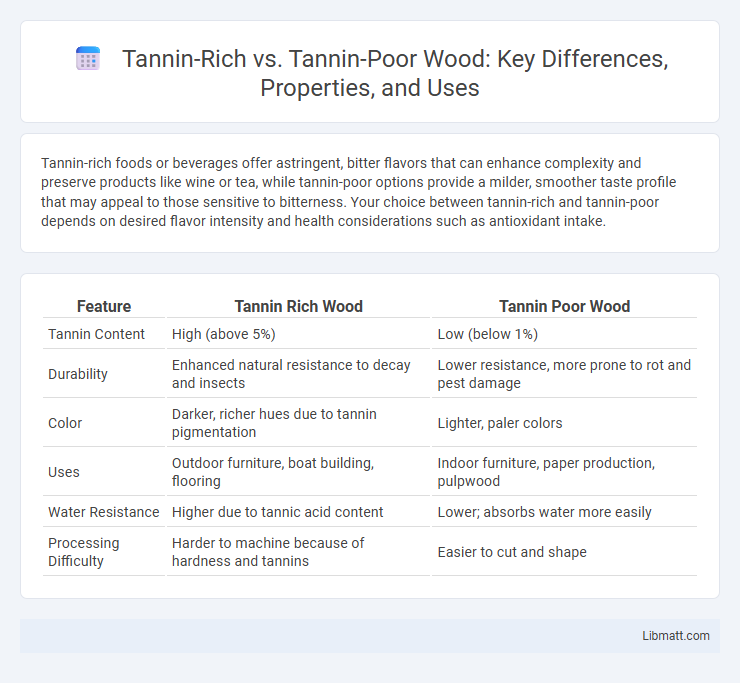Tannin-rich foods or beverages offer astringent, bitter flavors that can enhance complexity and preserve products like wine or tea, while tannin-poor options provide a milder, smoother taste profile that may appeal to those sensitive to bitterness. Your choice between tannin-rich and tannin-poor depends on desired flavor intensity and health considerations such as antioxidant intake.
Table of Comparison
| Feature | Tannin Rich Wood | Tannin Poor Wood |
|---|---|---|
| Tannin Content | High (above 5%) | Low (below 1%) |
| Durability | Enhanced natural resistance to decay and insects | Lower resistance, more prone to rot and pest damage |
| Color | Darker, richer hues due to tannin pigmentation | Lighter, paler colors |
| Uses | Outdoor furniture, boat building, flooring | Indoor furniture, paper production, pulpwood |
| Water Resistance | Higher due to tannic acid content | Lower; absorbs water more easily |
| Processing Difficulty | Harder to machine because of hardness and tannins | Easier to cut and shape |
Understanding Tannins: An Overview
Tannins are naturally occurring polyphenolic compounds found in plants, influencing the taste, color, and mouthfeel of foods and beverages like wine and tea. Tannin-rich foods and drinks exhibit astringency and bitterness due to high tannin concentration, impacting flavor complexity and preservation qualities. Understanding your preference between tannin-rich and tannin-poor options can enhance your culinary and sensory experience, guiding choices tailored to taste and health benefits.
Tannin-Rich vs Tannin-Poor: Key Differences
Tannin-rich substances contain high levels of polyphenolic compounds that contribute to astringency, antioxidant properties, and antimicrobial effects, commonly found in foods like red wine, tea, and unripe fruits. Tannin-poor counterparts have significantly lower concentrations, leading to milder flavors, reduced bitterness, and less potent preservative qualities. The key differences impact food texture, flavor profile, and health benefits, influencing consumer preference and industrial applications in food processing and pharmaceuticals.
Natural Sources of Tannins
Natural sources of tannins vary significantly between tannin-rich and tannin-poor plants, with tannin-rich sources including tea leaves, oak bark, and certain fruits like pomegranates and grapes. Tannin-poor plants, such as most vegetables and grains, contain considerably lower levels of these polyphenolic compounds, influencing your dietary intake and potential health benefits. Understanding the distinction between these sources helps optimize your use of tannins for antioxidant and astringent effects.
Health Benefits of Tannin-Rich Foods
Tannin-rich foods, such as green tea, berries, and nuts, are known for their potent antioxidant properties that help combat oxidative stress and reduce inflammation. These compounds support cardiovascular health by improving blood vessel function and lowering LDL cholesterol levels. Incorporating tannin-rich foods into your diet may enhance overall well-being and provide protection against chronic diseases.
Drawbacks of High Tannin Consumption
High tannin consumption can lead to reduced nutrient absorption, particularly iron, causing potential anemia in susceptible individuals. Excessive intake may also result in gastrointestinal discomfort, including nausea and stomach irritation. Moreover, tannins' astringent properties can negatively affect taste perception and interfere with protein digestibility.
Culinary Uses: Tannin-Rich vs Tannin-Poor Ingredients
Tannin-rich ingredients like red wine, black tea, and certain nuts add depth and bitterness to savory dishes, enhancing marinades and stews by tenderizing meat and balancing rich flavors. Tannin-poor ingredients such as white wine, fresh fruits, and dairy create a smoother, milder profile ideal for delicate sauces, desserts, and beverages where astringency is undesired. Understanding the tannin content helps you select the right ingredient to achieve the perfect flavor balance in your culinary creations.
Tannin Content in Beverages: Tea, Wine, and More
Tannin content varies significantly between beverages, with tea and red wine being particularly rich sources due to their polyphenolic compounds derived from leaves and grape skins, respectively. Tannin-rich beverages like black tea and red wine offer astringency and potential antioxidant benefits, while tannin-poor drinks such as white wine and green tea exhibit milder flavor profiles and lower astringency. Understanding tannin concentration helps in selecting beverages for flavor preference and potential health effects related to catechins and other tannin-related antioxidants.
Impact of Tannins on Taste and Texture
Tannin-rich foods contribute astringency and bitterness, creating a drying sensation that enhances complexity and mouthfeel in beverages like red wine and tea. Tannin-poor options offer a smoother, mellower taste with less grip, making them more approachable for those sensitive to bitterness. Your choice between tannin-rich and tannin-poor products significantly influences the balance of flavor intensity and texture in the culinary experience.
Tannins and Nutrient Absorption
Tannins, found in tannin-rich foods like tea, coffee, and certain fruits, can inhibit nutrient absorption by binding to proteins, iron, and other minerals in the digestive tract, reducing their bioavailability. Your body may absorb fewer nutrients from tannin-rich foods compared to tannin-poor alternatives, which typically allow for better nutrient uptake due to lower interference with digestive enzymes. Choosing tannin-poor foods can support improved absorption of essential vitamins and minerals, promoting optimal nutritional status.
Choosing Between Tannin-Rich and Tannin-Poor Options
Choosing between tannin-rich and tannin-poor options depends on the desired flavor intensity and astringency in food or beverages. Tannin-rich varieties, found in red wines, certain teas, and unripe fruits, provide robust bitterness and complexity, beneficial for aging and digestion. Tannin-poor options suit those preferring smoother, less bitter tastes, often found in white wines, herbal teas, and ripe fruits, enhancing freshness and immediate palatability.
Tannin rich vs Tannin poor Infographic

 libmatt.com
libmatt.com